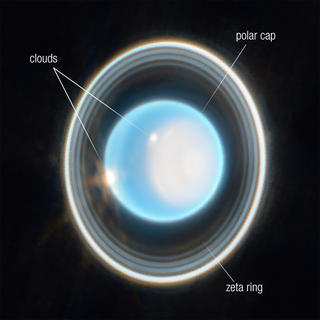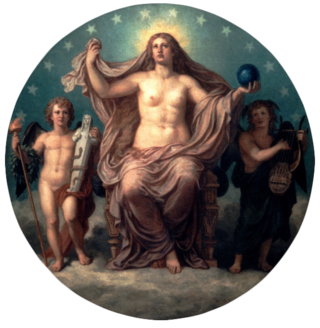Uranian may refer to:
Uranian may refer to:

Miranda, also designated Uranus V, is the smallest and innermost of Uranus's five round satellites. It was discovered by Gerard Kuiper on 16 February 1948 at McDonald Observatory in Texas, and named after Miranda from William Shakespeare's play The Tempest. Like the other large moons of Uranus, Miranda orbits close to its planet's equatorial plane. Because Uranus orbits the Sun on its side, Miranda's orbit is perpendicular to the ecliptic and shares Uranus' extreme seasonal cycle.

Umbriel is a moon of Uranus discovered on October 24, 1851, by William Lassell. It was discovered at the same time as Ariel and named after a character in Alexander Pope's 1712 poem The Rape of the Lock. Umbriel consists mainly of ice with a substantial fraction of rock, and may be differentiated into a rocky core and an icy mantle. The surface is the darkest among Uranian moons, and appears to have been shaped primarily by impacts. However, the presence of canyons suggests early endogenic processes, and the moon may have undergone an early endogenically driven resurfacing event that obliterated its older surface.

Uranus is the seventh planet from the Sun and is a gaseous cyan ice giant. Most of the planet is made out of water, ammonia, and methane in a supercritical phase of matter, which in astronomy is called 'ice' or volatiles. The planet's atmosphere has a complex layered cloud structure and has the lowest minimum temperature of 49 K out of all Solar System's planets. It has a marked axial tilt of 97.8° with a retrograde rotation rate of 17 hours. This means that in an 84 Earth years orbital period around the Sun, its poles get around 42 years of continuous sunlight, followed by 42 years of continuous darkness.

Oberon, also designated Uranus IV, is the outermost major moon of the planet Uranus. It is the second-largest, with a surface area that is compareable to the area of Australia, and second most massive of the Uranian moons, and the ninth most massive moon in the Solar System. Discovered by William Herschel in 1787, Oberon is named after the mythical king of the fairies who appears as a character in Shakespeare's A Midsummer Night's Dream. Its orbit lies partially outside Uranus's magnetosphere.

Urania was, in Greek mythology, the muse of astronomy. Urania is the goddess of astronomy and stars, her attributes being the globe and compass.

Titania, also designated Uranus III, is the largest of the moons of Uranus and the eighth largest moon in the Solar System at a diameter of 1,578 kilometres (981 mi), with a surface area comparable to that of Australia. Discovered by William Herschel in 1787, it is named after the queen of the fairies in Shakespeare's A Midsummer Night's Dream. Its orbit lies inside Uranus's magnetosphere.

Ariel is the fourth-largest of the 27 known moons of Uranus. Ariel orbits and rotates in the equatorial plane of Uranus, which is almost perpendicular to the orbit of Uranus and so has an extreme seasonal cycle.
The Uranians were a late-19th-century and early-20th-century clandestine group of up to several dozen male homosexual poets and prose writers who principally wrote on the subject of the love of adolescent boys. In a strict definition they were an English literary and cultural movement; in a broader definition there were also American Uranians. The movement reached its peak between the late 1880s and mid 1890s, but has been regarded as stretching between 1858, when William Johnson Cory's poetry collection Ionica appeared, and 1930, the year of publication of Samuel Elsworth Cottam's Cameos of Boyhood and Other Poems and of E. E. Bradford's last collection, Boyhood.
Uranian is a historical term for homosexual men. The word was also used as an adjective in association with male homosexuality or inter-male attraction regardless of sexual orientation.

Uranus, the seventh planet of the Solar System, has 27 known moons, most of which are named after characters that appear in, or are mentioned in, the works of William Shakespeare and Alexander Pope. Uranus's moons are divided into three groups: thirteen inner moons, five major moons, and nine irregular moons. The inner and major moons all have prograde orbits, while orbits of the irregulars are mostly retrograde.

The rings of Uranus are intermediate in complexity between the more extensive set around Saturn and the simpler systems around Jupiter and Neptune. The rings of Uranus were discovered on March 10, 1977, by James L. Elliot, Edward W. Dunham, and Jessica Mink. William Herschel had also reported observing rings in 1789; modern astronomers are divided on whether he could have seen them, as they are very dark and faint.

In astrology, a planet's domicile is the zodiac sign over which it has rulership. This is a separate concept from the houses of the horoscope. A planetary ruler is given to each sign, over which the planet is said to have a more powerful influence when positioned therein. The ruling planet associated with a sign is also used as an implied focus of interpretation for the signs on house cusps in a chart. A planet is considered to be in domal dignity when it is positioned in the sign it rules. This is the strongest of the five essential dignities of a planet.
Urania is a muse in Greek mythology.

Historically, astrological and astronomical symbols overlapped. Frequently used symbols include signs of the zodiac and classical planets. These originate from medieval Byzantine codices. Their current form is a product of the European Renaissance. Other symbols for astrological aspects are used in various astrological traditions.
The Uranians are a fictional race appearing in American comic books published by Marvel Comics. They first appeared in Marvel Boy #1 (1950) as the human-like inhabitants of the planet Uranus, who became the hosts and mentors of Marvel Boy and provide him with the technology which he used on Earth to become a superhero. Uranians were originally described as an utopian society of extraterrestrials native to Uranus who had found scientific cures for aging, disease, crime, and other illnesses, but they were later retconned as a colony of the Eternals, an offshoot of humanity that possessed near-immortality, super-powers and vastly advanced technology even before the founding their colony on Uranus.
Uranus is a planet in the Solar System.

Aphrodite Urania was an epithet of the Greek goddess Aphrodite, signifying a "heavenly" or "spiritual" aspect descended from the sky-god Ouranos to distinguish her from the more earthly epithet of Aphrodite Pandemos, "Aphrodite for all the people". The two were used to differentiate the more "celestial" love of body and soul from purely physical lust. Plato represented her as a daughter of the Greek god Uranus, conceived and born without a mother. Hesiod described this aspect as being born from the severed genitals of Uranus and emerged from the sea foam.

In astrology, planets have a meaning different from the astronomical understanding of what a planet is. Before the age of telescopes, the night sky was thought to consist of two similar components: fixed stars, which remained motionless in relation to each other, and moving objects/"wandering stars", which moved relative to the fixed stars over the course of the year(s).

Asteroid 2011 QF99 is a minor planet from the outer Solar System and the first known Uranus trojan to be discovered. It measures approximately 60 kilometers (37 miles) in diameter, assuming an albedo of 0.05. It was first observed 29 August 2011 during a deep survey of trans-Neptunian objects conducted with the Canada–France–Hawaii Telescope, but its identification as Uranian trojan was not announced until 2013.
In Greek mythology, Urania may refer to the following divinities: